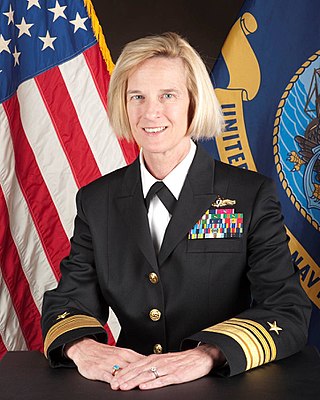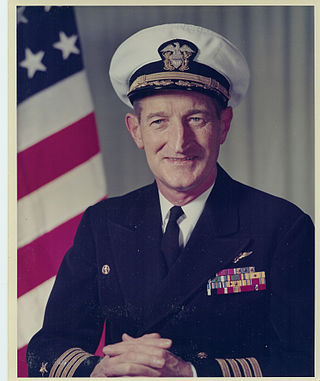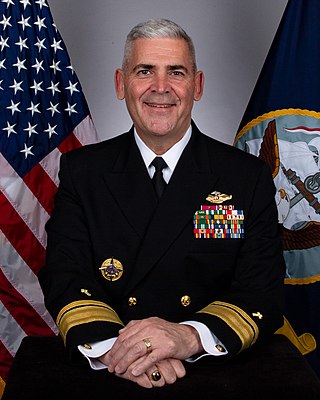
Command master chief petty officer (CMDCM) is an enlisted rating in the United States Navy and U.S. Coast Guard, as well as the Japan Maritime Self-Defense Force.
The Combat Action Ribbon (CAR) is a United States Navy, United States Coast Guard, and United States Marine Corps military decoration awarded to United States sea service members "who have actively participated in ground or surface combat." Coast Guardsmen, Navy sailors, and Marines active in clandestine, stealth or special operations are deemed eligible for consideration of the award. The ribbon is awarded to members of the Navy and Marine Corps with a rank no higher than captain and colonel, respectively.

A drill instructor is a non-commissioned officer in the armed forces, fire department, or police forces with specific duties that vary by country. Foot drill, military step, and marching are typically taught by drill instructors.
The Navy "E" Ribbon or Battle Efficiency Ribbon was authorized on March 31, 1976, by Secretary of the Navy J. William Middendorf as a unit award for battle efficiency competition. The service ribbon replaced the "E" patch previously sewn on the right sleeve of the enlisted naval uniform for rates/pay grades E-1 through E-6.
A Sea Service Ribbon is an award of the United States Navy, U.S. Marine Corps, U.S. Coast Guard, the U.S. Army, and the NOAA Commissioned Officer Corps which recognizes those service members who have performed military duty while stationed on a United States Navy, Coast Guard, Army, or NOAA vessel at sea and/or members of the Navy, Marine Corps or Coast Guard who have been forward-deployed with their home unit.
The Fleet Marine Force Warfare Insignia, also known as the Fleet Marine Force badge or FMF pin, are three military badges of the United States Navy which are issued to those U.S. Navy officers and sailors who are trained and qualified to perform duties in support of the United States Marine Corps. There are currently three classes of the Fleet Marine Force pin, being that of enlisted, officer, and chaplain.

The Good Conduct Medal is one of the oldest military awards of the United States Armed Forces. The U.S. Navy's variant of the Good Conduct Medal was established in 1869, the Marine Corps version in 1896, the Coast Guard version in 1923, the Army version in 1941, and the Air Force version in 1963; the Air Force Good Conduct Medal was temporarily discontinued from February 2006 to February 2009, followed by its subsequent reinstatement.

The surface warfare insignia is a military badge of the United States Navy which is issued to U.S. Navy personnel who are trained and qualified to perform duties aboard United States surface warships. There are presently four classes of the surface warfare pin, being that of line, staff, special operations, and enlisted. The line and enlisted surface warfare badges may be earned by United States Coast Guard personnel assigned to Navy commands. The various badge types are as follows:
The Marine Corps Security Guard Ribbon is a United States Marine Corps military award that was established by order of Secretary of the Navy John Howard Dalton on 15 July 1997. The award recognizes those Marine Corps personnel who have served as U.S. Embassy Security Guards and is retroactive to 28 January 1949.

The Meritorious Service Medal (MSM) is a military award presented to members of the United States Armed Forces who distinguish themselves with outstanding meritorious achievement or service to the United States.
A Drill Instructor Ribbon is a military award of the United States Armed Forces which is issued by the U.S. Navy, U.S. Air Force, U.S. Space Force, and U.S. Marine Corps. The Drill Instructor Ribbon recognizes those service members who are trained and qualified as military instructors to new recruits during initial basic training.

Insignias and badges of the United States Navy are military badges issued by the United States Department of the Navy to naval service members who achieve certain qualifications and accomplishments while serving on both active and reserve duty in the United States Navy. Most naval aviation insignia are also permitted for wear on uniforms of the United States Marine Corps.

Admiral Joseph James "Jocko" Clark, USN was an admiral in the United States Navy, who commanded aircraft carriers during World War II. Born and raised in Indian Territory and a member of the Cherokee Nation, in 1917 he became the first Native American to graduate from the United States Naval Academy. Clark preferred to be called "J. J." or by the nickname "Jocko" instead of his full name.

The United States Navy Reserve (USNR), known as the United States Naval Reserve from 1915 to 2005, is the Reserve Component (RC) of the United States Navy. Members of the Navy Reserve, called Reservists, are categorized as being in either the Selected Reserve (SELRES), the Training and Administration of the Reserve (TAR), the Individual Ready Reserve (IRR), or the Retired Reserve.

The United States Air Force Honor Guard is the official ceremonial unit of the United States Air Force and is assigned to Joint Base Anacostia-Bolling, Washington D.C.

Carol M. Pottenger is a retired United States Navy flag officer. She was among the first women to be assigned to serve at sea in 1978, the first female admiral to command a major combat organization, Amphibious Force 7th Fleet/Expeditionary Strike Group Seven, encompassing the amphibious forces assigned to the western Pacific; and the first female admiral to lead a combatant force "type command", Navy Expeditionary Combat Command, charged with the manning, training and equipping of over 40,000 expeditionary sailors in preparation for combat deployments to Iraq and Afghanistan, as well as global security assistance operations. Her final naval post was with NATO as deputy chief of staff for capability and development at Supreme Allied Commander Transformation, Norfolk, Virginia, the first female officer to hold this position.

Frederick T. Moore Jr. was a United States Navy captain. During World War II, he was executive officer of Fighter Squadron 1 operating off the carrier USS Yorktown (CV-10) and commanding officer of the Air Group 35 aboard the aircraft carrier USS Chenango in the Pacific. During the Korean War, he was the commanding officer of naval air training at NAS Pensacola and the air officer on USS Coral Sea. His first sea command was aboard USS Suribachi. In 1962–1963, Moore was the eighth commanding officer of USS Saratoga. Late in his career during the Vietnam War, he was Chief of Staff of the Naval Air Training Command at Naval Air Station Pensacola from October 1965 to July 1969.

Gregory N. Todd is a United States Navy rear admiral and chaplain who serves as the 28th Chief of Chaplains of the United States Navy. He previously served as the 20th Chaplain of the Marine Corps. He also served for four years as the tenth Chaplain of the Coast Guard. Over a thirty-two year career, he has served in a variety of Navy, Marine Corps, and Coast Guard assignments, including deployments to Iraq and Afghanistan and chaplaincy work at Ground Zero in the wake of the September 11 attacks. He is a Lutheran.

The United States Navy Ceremonial Guard is the official ceremonial unit of the United States Navy. It is responsible for the performance of public duties in the U.S. Navy. The guard is composed of 200+ enlisted navy personnel. It is based at Naval District Washington, Washington Navy Yard, Washington D.C. It is currently led by Commander Alexander McMahon.














